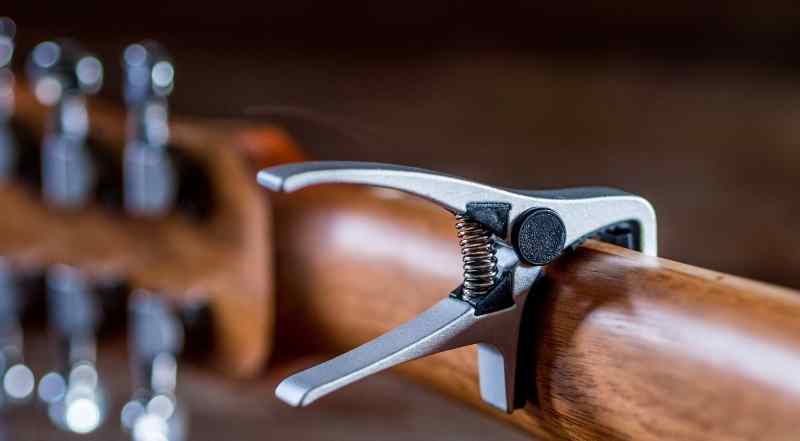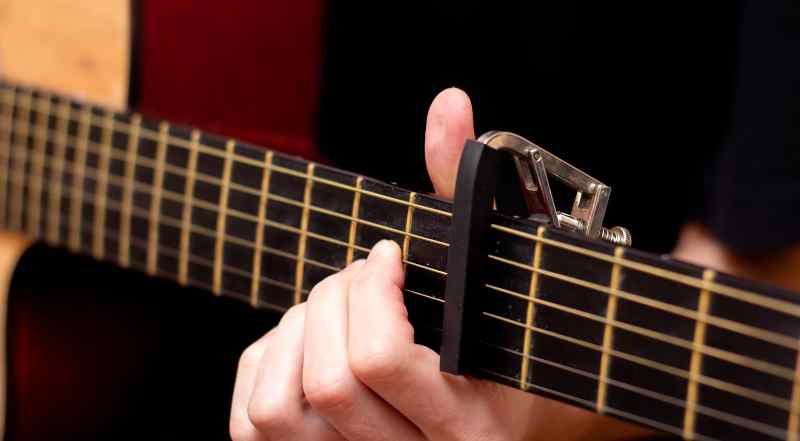Have you ever wondered about that small yet mighty tool that guitarists often attach to the neck of their guitars? That’s a guitar capo! It’s a nifty little device that holds immense power in music. Let’s dive into the world of the guitar capo and explain what it is and what it does in simple, everyday language.

The Basics: What is a Guitar Capo
Alright, let’s break it down. You might have seen one – that clamp-like device on the neck of a guitar. But what exactly is it? Well, that’s a guitar capo. It’s like a magic tool that can transform your guitar playing surprisingly. A guitar capo is like a movable frame. It clamps down on a specific fret and essentially shifts your guitar’s ‘starting point’. When you place the capo on a fret and strum, you change the pitch without touching the tuning pegs.
How Does a Guitar Capo Work?
Now, you might wonder, “How does this magic happen?” Well, it’s all about shortening the vibrating length of the strings. When you press down a string behind the capo, you’re effectively creating a new nut, and each fret you go up increases the pitch. Imagine using your finger as a temporary nut, but way more precise and consistent.
Types of Guitar Capos
Alright, let’s talk about variety! Guitar capos come in different shapes and sizes. You’ve got your standard spring-loaded capos, elastic capos, toggle capos, and even the advanced ones like the partial capos, which cover only a few strings. It’s like a Capo World carnival out there!
Using a Capo – How and When
Now, let’s get practical. How do you use a capo, and when should you use it?
Placing the Capo
It’s easy. Just clamp the capo onto a specific fret, and it presses down on the strings, effectively shortening the playable length of the strings beyond the capo. The fret where you place the capo determines the new key you’ll be playing in.
Why Use a Capo?
There are several reasons. It can make a song easier to sing by changing the key. It can also create a unique tone and atmosphere for your music. Plus, it’s handy for accommodating different vocal ranges if you play with others.
Capo Styles and Tips
Now that you know what does a capo do, let’s explore some different capo styles and offer a few tips:
Capo Styles
There are various capo designs, including spring-loaded, toggle, and partial capos. Each has its advantages and best uses.
Proper Placement
Make sure to place the capo evenly on the fret so it doesn’t cause your guitar to go out of tune. Gently press down the strings so they are clear of the fret beneath the capo.
Experiment
Don’t be afraid to experiment with capo placements. Changing the fret position can give you entirely new sounds and moods.
Conclusion
I hope now you know what a guitar capo is and also what it does. In a nutshell, a guitar capo is a musician’s best friend. It lets you explore different sounds, experiment with your music, and play in various keys without wrestling with complicated fingerings. So, don’t hesitate to grab one and start experimenting with the beautiful world of capo-assisted guitar playing!
FAQs
Yes, whether acoustic, electric, or classical, a capo is versatile and works with all guitar types.
No, a capo can change the key easily, but it doesn’t replace the need to learn various chords. It’s a helpful tool but doesn’t replace chord mastery.
Yes, a capo is great for songs where you need to adjust the pitch for your voice or create a particular mood. It’s commonly used in folk, rock, and pop music.
When used correctly, a capo won’t harm your guitar. Just ensure it’s placed right, not too tight, and avoid leaving it on when not playing for a long time.
Yes, you can achieve a similar effect by pressing down on the strings with your fingers. However, a capo is more efficient and consistent in holding down all the strings at once.

